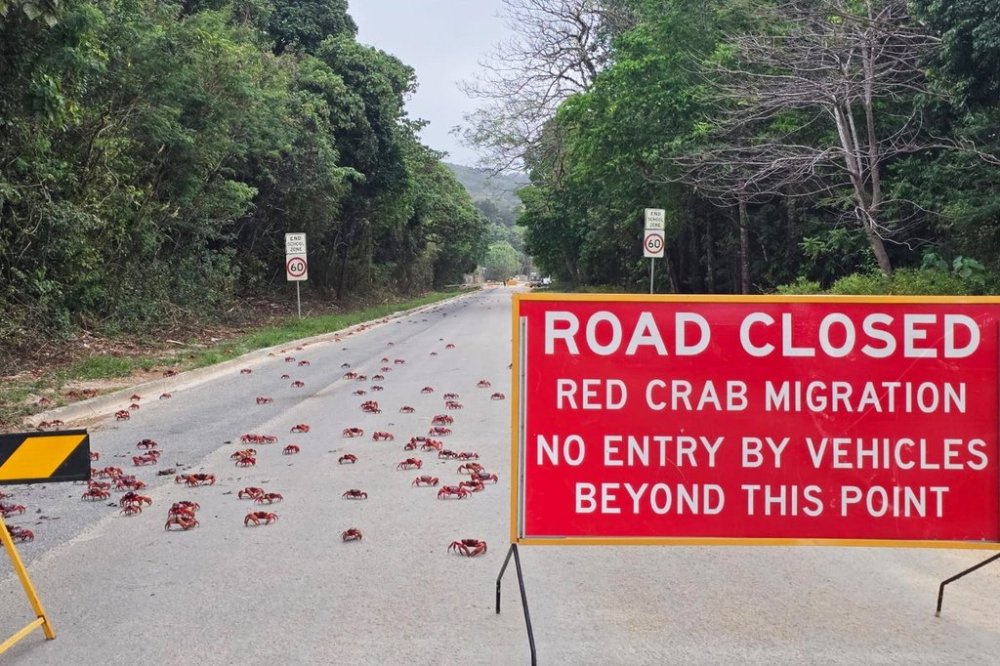World
Millions of Red Crabs Migrate on Christmas Island as Locals Assist

Tens of millions of red crabs are currently migrating to the ocean on Christmas Island, a remote Australian territory located in the Indian Ocean. The event marks the annual migration of these crabs, known scientifically as Gecarcoidea natalis. Local residents, numbering around 1,200, are actively helping the crabs navigate their journey using garden tools such as leaf blowers and rakes.
The migration is triggered by the onset of the Southern Hemisphere’s summer rains, which began last weekend. According to Alexia Jankowski, acting manager of Christmas Island National Park, the population of red crabs on the island can reach up to 200 million. Approximately 100 million of these crabs are expected to make the trek from their forest burrows to the shoreline, where they will breed.
Jankowski noted that during this period, the crabs prefer to seek shade during the heat of the day. The most active times for their migration are early mornings and late afternoons, when they slowly make their way across roads and gardens towards the coast. Residents are generally supportive of the crabs’ presence, viewing them as a natural spectacle rather than a nuisance.
“Some people might think they’re a nuisance, but most of us think they’re a bit of a privilege to experience,” Jankowski explained. She added that the crabs are persistent in their journey, often entering homes if doors are left open. Residents sometimes find themselves raking crabs out of their driveways to avoid injury to the crustaceans when attempting to leave their homes.
Once the crabs reach the shore, males excavate burrows where females will spend about two weeks laying and incubating their eggs. It is anticipated that the females will release their spawn into the ocean at high tide on either November 14 or November 15, coinciding with the last quarter of the moon. The young crabs will then spend a month as tiny larvae in ocean currents before returning to Christmas Island.
Jankowski emphasized the care taken to protect the young crabs during this vulnerable stage. “When they’re little babies only about half the size of your fingernail, we can’t rake them, because you’d crush them. So instead, we use leaf blowers,” she noted. This creative approach aims to minimize the impact of vehicle traffic on the roadways as the young crabs make their way to the ocean.
The collaborative efforts between the local population and the natural world highlight a unique relationship that celebrates the rhythm of nature on Christmas Island. As the migration unfolds, the crabs serve as a reminder of the interconnectedness of ecosystems and the responsibility of humans to protect them.
-

 World3 months ago
World3 months agoScientists Unearth Ancient Antarctic Ice to Unlock Climate Secrets
-

 Entertainment3 months ago
Entertainment3 months agoTrump and McCormick to Announce $70 Billion Energy Investments
-

 Lifestyle3 months ago
Lifestyle3 months agoTransLink Launches Food Truck Program to Boost Revenue in Vancouver
-

 Science3 months ago
Science3 months agoFour Astronauts Return to Earth After International Space Station Mission
-

 Technology2 months ago
Technology2 months agoApple Notes Enhances Functionality with Markdown Support in macOS 26
-

 Top Stories2 weeks ago
Top Stories2 weeks agoUrgent Update: Fatal Crash on Highway 99 Claims Life of Pitt Meadows Man
-

 Sports3 months ago
Sports3 months agoSearch Underway for Missing Hunter Amid Hokkaido Bear Emergency
-

 Politics3 months ago
Politics3 months agoUkrainian Tennis Star Elina Svitolina Faces Death Threats Online
-

 Technology3 months ago
Technology3 months agoFrosthaven Launches Early Access on July 31, 2025
-

 Politics3 months ago
Politics3 months agoCarney Engages First Nations Leaders at Development Law Summit
-

 Entertainment3 months ago
Entertainment3 months agoCalgary Theatre Troupe Revives Magic at Winnipeg Fringe Festival
-

 Politics2 weeks ago
Politics2 weeks agoShutdown Reflects Democratic Struggles Amid Economic Concerns









